
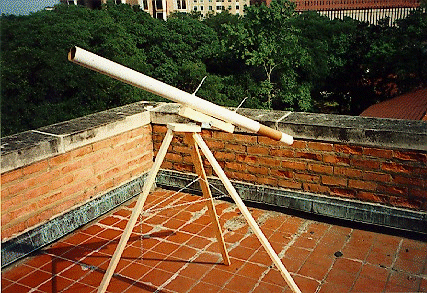
We, the first ever astronomy group of History 333, were given the task of recreating Galileo's observations using replicas of the Galilean-style telescope. On a limited budget, our group had to design and build a set of these telescopes. This link discusses the design that was created by our group. For more information on telescopes in general, see the telescope link in the Galileo Project. For some of the books that were used for ideas on the design of this telescope, as well as some good references on Galilean telescopes, check out the telescope section in the Galileo Project Astronomy Bibliography. A special thanks to Tom Williams for his guidance on the telescope creation.
Note: The easiest way to create the telescope is by looking at past models. If at all possible, get a hold of one, which will be a better teacher than the following instructions ever could.
The basic premise of the telescope tube is to align two lenses the appropriate distance from each other. For this telescope, the lenses are a concave convex (one side curved out and the other curved in) and a plano concave (one flat side and one side curved in). The plano concave lens is used as the "eyepiece" with the plano (flat) side facing the eye. The concave convex is used as the "objective lens" that is aligned with the eyepiece and with the convex side facing the sky. Notice that this lens is actually different than the plano convex lens used in the original Galilean telescope, but still gives the same results.
The following design uses pieces of the inner tube of the mailing tube to hold the lenses in place inside the outer tube. This is best illustrated in the following diagram, which shows the cross section of the telescope tube:

The outer tube of the mailing tube should have a short end that pulls off, and this can be used for the split in the outer tube shown above. This end will be used to hold the eyepiece. The inner tube must have two pieces (about 1" to 1.5" each) cut off of it that will be used as spacers to hold the objective lens in place. Make these cuts as straight and clean as possible, which will be difficult since the tube is made out of cardboard. A coping saw works pretty well for this.
Take the short piece of the outer tube and cut or drill a hole (from 3/16" to 5/16" should be fine) directly in the center of the metal cap on the end. This will be the eyehole. It is important that this hole be as clean as possible (no metal protrusions) so that the the flat side of the eyepiece will fit snugly against the metal cap. An electrician's hole punch or Greenlee Punch works well for this task. If a drill is used, drill with a light pressure, then smooth out the inside surface as much as possible.
Place the eyepiece flush (flat side) against the inside of this eyehole. The large piece of the inner mailing tube left will be used to hold this in place. To do this, drill small holes around the outside of the eyepiece tube. Then, with the eyepiece properly in place, slide the inner tube into it, put glue into the holes, and turn the tube a little bit to spread the glue inside. Hold the tube snugly against the lens inside the cap until the glue dries.
Now, put this aside and take the large outer tube and the two spacers cut from the inner tube. Cut the closed end off of the outer tube, then use the other end to mount the objective lens (since that end already has a clean cut). Again, the "drill holes - put in glue" technique will be used to hold the spacers in place. First, check how far the inner spacer needs to be placed inside the tube so that the lens and other spacer will be able to sit inside the tube comfortably. Then drill holes in the outer tube around this area and glue in the spacer as before.
After the first spacer is in place and dry, place the concave side of the objective lens flush against it, and put the other spacer snugly against the lens to hold it in place (again using the drill - glue method).
Now there are two pieces, each containing one of the lenses. Slide the mailing tubes together as shown in the drawing above, and the telescope is done. By leaving these two pieces unglued, the telescope may be focused simply by sliding the eyepiece part inside the objective part. After a desired magnification/focus is found, the two pieces may be permanently attached (or some tape will give a semi-permanent attachment).
Two images of a finished tube are shown below:
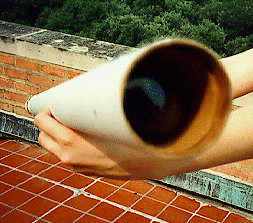
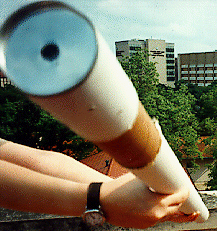
Parts List (With approximate cost for the given quantity):
Instructions:
First, the telescope tube must be mounted. Take the 2x2 piece and find the center of it (on a long side). Drill directly through the center. This hole will be used for mounting the tube assembly onto the tripod. To mount the tube onto the 2x2, take the two cable tie mounts and place them parallel to each other near the two ends of one side of the 2x2 (not on one of the drilled sides). Then lay the tube across these two mounts and use the cable ties to strap it into place.
Next, the tripod must be built. The 1x4 will be called the "base" from now on and will be the most important part in the following instructions. Take the base and screw on the three hinges on one side of it. The hinges should be placed at 120 degree angles with respect to one another (like a peace sign, if that helps with the visual), with the hinged side facing away from the center. The following picture shows how the three hinges should be mounted on the bottom of the base.

As shown in the diagram above, a 3/16" hole should be drilled between the back hinges, B and C. This hole will be used later for mounting the hanger on the other side of the base. Leave enough room so that one of washers may be placed around the hole and will not touch the hinges. On the other side, make sure the hole is back far enough so that the tube mounting (once mounted on the hanger) will have a great deal of up down movement before hitting the base.
Next, the tripod legs (the 1x2s) can be attached to the hinges, however, pay careful attention to the following instructions first. The hinge on the front (opposite the hole) should have the leg mounted on the outside, so that the top of the leg will hit the bottom of the base when it is pulled out. This is done to provide stability for the hinges, which will otherwise wobble in place. The other two legs should be mounted on the inside of their respective hinges, so that they can be pulled out as far as is desired. When attaching the front leg to the outside of hinge A, leave about 1/8" to 1/4" between the top of it and the base, so that it will be able to pull out some before hitting the base. It is important that this leg hit the base flushly upon its top edge, so be extra careful to keep it straight when screwing it in. If the directions above are not entirely clear, the picture below should give visual clarification. Notice how the front leg is on the outside of hinge A and rests against the bottom of the base. Notice also how the two back legs are attached to the inside of their respective hinges.
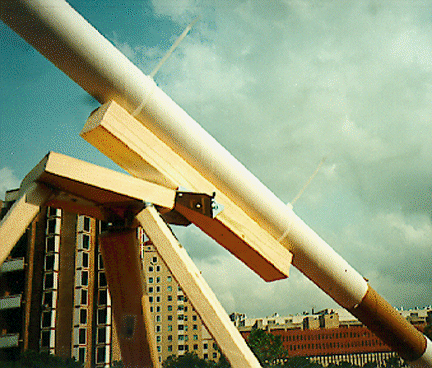
One eyescrew should be attached to the inside of each leg about 1/3 of the way down from the base. The chain may then be used to connect them, and will then act as a stop on the legs when they are pulled apart. By adjusting the distance of chain between the legs, the height of the tripod may then be adjusted. When setting up the tripod at any time, make sure the chain is in place and that the legs are all pushed out as far as they will go (especially the front leg, which should have a flush edge against the base when extended), or else the tripod will not be completely stable.
Finally, the 1.5" machine screw and a wing nut (using washers if desired) may be used to attach the bottom of the hanger to the top side of the base. The wing nut should be adjusted to allow a rotational movement of the hanger, thus providing the azimuth movement of the telescope. Do not, however, leave the wing nut so loose that the hanger spins freely.
The 2" machine screw and a wing nut (again using washers if desired) is used to attach the 2x2 through the two sides of the hanger. Again, tighten the wing nut enough to allow movement (this time the altitude movement of the telescope), but to still hold the 2x2 steadily in place.
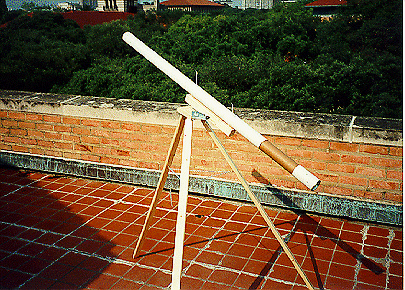
For easy transportation of the telescope, remove the 2" machine screw from the hanger and carry the the tube mounting and tripod separately.
* The hinges used in the original design had the following shape:

These worked well because they gave a lot of surface area when attached to the tripod legs and base, and could all fit on the base piece. This is not a hard rule though and other types of hinges may be substituted if desired.
** Improvisation must be used for the metal hanger piece. An example of something that might make a good hanger piece is shown below:

However, a piece that looks like this will not be found in any hardware store. Thus, improvisation must be used for the metal hanger piece. It can either be made from scratch or by modifying some existing item that might work. The important criteria for the hanger are as follows:
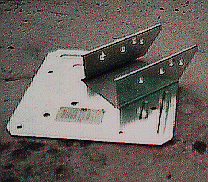
To do the field of view measurements, find a bright star near the celestial equator
with the telescope. Put the star just outside the field of view of the telescope,
and measured the time it takes for the star to travel across the field of view,
until it is just outside of it. Make sure the star travels directly accross the
diameter of the field of view, and not across one of it's chords. The time
measurement can then be placed into the following equation, which will give
arcseconds when the time is given in seconds or arcminutes when the time
is given in minutes:
Field of View = Time[(360)(60)/1436]cos(star declination)
Some of the star declinations for the brighter stars are:














 We appreciate any comments or suggestions.
We appreciate any comments or suggestions.